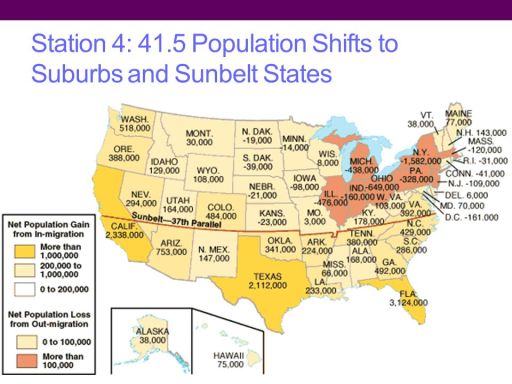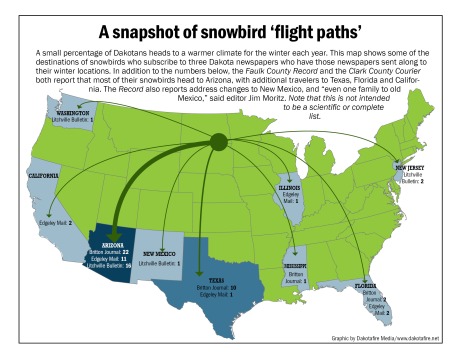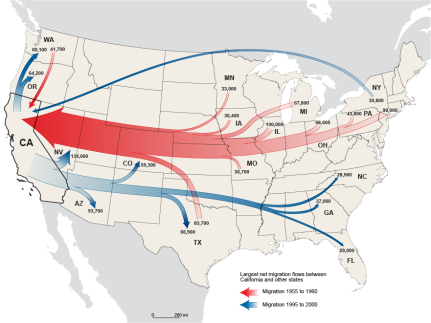It’s always about stories – and all the stories we tell are ultimately about ourselves. The American mobility story includes a south/north variant. Millions of African-Americans left the South between 1920 and 1970. Their motivation was perhaps less about the entrepreneurial spirit and more about the refugee experience. They escaped the terror of a Jim Crow society for the promise of freedom in northern cities. Many of them, like the whites moving east to west, found that freedom and new opportunity as well.
Others, however, realized that they’d accepted a Devil’s bargain, trading away their old communal values for this new sense of individualism. Indeed, they composed a whole new sub-genre of blues music: longing for the country life and the old folks at home. Those who did remain in the South were more tied to the land, more religious and more conservative. And as we’ll see, this was true for whites as well.
America experienced an even larger demographic change a generation after the Civil War. For the first time, movement began to reverse (except for those still heading to California), back toward the cities. This was partially because of the closing of the frontier. After the Oklahoma land rush, most of the good land was taken (by large corporations, but that’s another story), and family farms took the brunt of capitalist centralization of the economy. Histories of late 19th and early 20th centuries typically emphasize the mass European immigration into the eastern cities but tend to ignore a nearly equal migration – some twenty million people – from the country back to the city. By 1920, despite the lingering mythic narrative, America was primarily an urban nation.
The migration of country people enriched the city but – this is crucial to understand – severely shrunk rural diversity, even as the outmoded and unchanging Electoral College ensured that the rural states retained their influence in Congress. This has been continuing for 130 years or more.
And the story is full of ironies. Kansas, for example, is now governed by one of the most reactionary bunch of thugs imaginable. But during the Populist/Progressive era of the early 1900s the state was a center of radical politics. For the full story, read Thomas Frank’s What’s the Matter With Kansas?
During the Depression, large numbers of dispossessed farmers abandoned the “dust bowl” of Oklahoma, Texas and other prairie states and attempted to make a new life in California. Altogether, some 3.5 million people left the area.
And in the 1970s through the 1990s, Big Business outsourced jobs to the Third World, causing steel-producing jobs to decline from 400,000 to 140,000. The middle class moved to the suburbs, but those who’d lost out in the economic transition began another migration, this time from the “rust belt” toward the “sun belt.” 
From 1970 to 2006, Cleveland, Detroit, Buffalo, and Pittsburgh lost about 45% of their population and the sun belt population increased by 150%. The demographic transition also shifted congressional representatives from north to south, a factor that exacerbated the already unfair situation in the Electoral College.
But there is another issue having to do not with the desire to escape poverty but with the idea of diversity, and with the terrible pressure to conform in an age when everything is in flux. Granted, it’s natural to want to live among those we consider our tribe. Consider the seasonal migration of “snowbirds,” retired people escaping northern winters, who temporarily swell Arizona’s population by 300,000, and who cause Florida’s elderly population to fluctuate by nearly 20%. 
These days the word “village” more than any other seems to encompass our longings for community, which we (and much media advertising) still associate with the country. Remember the “back to the land” movement, when thousands of hippies established rural communes to escape the violence and ugliness of the cities? In 1969 Joni Mitchell sang:
Got to get back to the land and set my soul free…
We are stardust, we are golden
We are billion year old carbon
And we got to get ourselves back to the garden
Can you see now how much that impulse was rooted in American myth? Back in 1921, Al Jolson sang:
California, here I come
Right back where I started from…
That’s why I can hardly wait,
Open up that Golden Gate!
California, here I come!
Now let’s look at the roots of our current mess, and our broad topic of “Trump: Madness, Machines, Migrations and Mythology” from yet another perspective. Consider a hypothetical example of a progressive and/or gender-non-conforming and/or creative and/or pregnant and/or Pagan and/or atheist person growing up on a farm or in a small town in Iowa or any of thirty other “flyover” states and subject to family pressure to conform or even discrimination. Red-blue maps of these states consist of dark-blue islands in the cities surrounded by red exurbs and rural areas.
Or how about a person with no health insurance living in a state that hasn’t accepted Obamacare, or one who needs medical marijuana but lives in a state that hasn’t legalized it (funny how the state-by-state maps dealing with these issues nearly overlap the red-blue maps)?
Consider the internal pressure on such persons to think of moving to one of the two or three university cities in that state, or to Chicago, St. Louis, Minneapolis or Kansas City, or ultimately to New York or California. Or even to another country: the State Department estimates that between three and eight million non-military Americans, including 400,000 retirees, are living abroad, studying, missionizing, playing or simply escaping the madness.
California doesn’t simply symbolize freedom; it also leads the nation in the rate of economic growth, by more than twice the national average. Aside from less-educated Latino immigrants, the state tends to attract the highly educated, who (at least until this past election, when college-educated whites voted for Trump) are increasingly correlated with voting liberal. Democrats hold a 12-point edge in party identification among those with college degrees. Only twelve years ago the parties were even on that score. Consider also that educated people were relatively evenly spread across the nation’s cities in 1970. Now, writes Bill Bishop, author of The Big Sort: Why the Clustering of Like-Minded America Is Tearing Us Apart, college graduates have congregated in particular cities.
But that’s not the only reason people move here – or why some people move to more conservative areas. Bishop also writes:
The generation of ministers who built sprawling mega-churches in the new suburbs learned to attract their stadium-sized congregations through the “homogenous unit principle.” The new churches were designed for cookie-cutter parishioners, what one church-growth proponent described as “people like us.”
But demography does support democracy. After the 2008 election, when 69% of first-time voters supported Obama, Rich Lowry, editor of the National Review, complained:
It’s a bad thing for Republicans when you drill down into all these states, and see lots of new voters, newcomers…It’s like, where did all the Republicans go? Did they move to Utah?
After Obama’s re-election in 2012, Lindsey Graham was quite candid: “We’re not generating enough angry white guys to stay in business for the long term.” His solution to the obvious demographic trend of old white people dying off was, of course, to disenfranchise people of color, and it was already well under way. As I’ve shown earlier in this essay, the Republicans succeeded.
I’m not presenting myself as a detached observer. Long before I began to write about American myth, I unwittingly engaged in precisely the same east-west migration. Back then we called it “splitting for the coast.” The implication was clear: wherever “we” were, the “scene” was old, dark, violent, conforming, predictable, boring, oppressive, crowded and full of relatives with their impossible demands and expectations. Family was something to escape from. As James Hillman said, American psychology mirrored its economics: the isolated individual in a hostile world. Sammy Davis said “I gotta be me.” Sinatra gave everyone permission to do it “my way.” But even earlier, during World War One, Sophie Tucker had sung, “How Ya Gonna Keep ’em Down on the Farm after they’ve seen Paree? It was a very old story.
Demographic change is the final element in the Trump story, and the story of the collapse of democracy. Reactionaries were able to seize control of government in two-thirds of the states – and throw the 2000, 2004, 2008, 2012 (yes, an un-corrupted vote would have given Democrats supermajorities in both houses of Congress) and 2016 elections by gerrymandering, purging millions of voters and manipulating the machines – partially because thousands, perhaps millions of people left the “flyover” states for more welcoming social climates.
We’ll never know how many. But Bishop offers a telling statistic: “In 1976, only about a quarter of America’s voters lived in a county a presidential candidate won by a landslide margin. By 2004, it was nearly half.” Twelve years later, we can assume that this number has increased further.
Clinton (and in the primaries, almost certainly Sanders) took the entire west coast, along with Colorado and Nevada. More Californians voted for her in the general election – 62% – than at any time since Roosevelt’s 1936 re-election, and she took the state by over four million votes. She even won conservative Orange County. In Washington state’s King County, which includes Seattle, she received a higher percentage than Obama received in 2012. And politicians here have made clear their intention to resist Trump. But even though Democrats won supermajorities in both Senate and Assembly, Latino California Assembly Speaker Anthony Rendon says, “We woke up strangers in a strange land.”
I’m not judging anyone for the choices we made. And how many are dedicated enough to leave, say, Oakland, to move back to Kansas to help organize and re-convert it to a Blue state? But we can imagine: what if half of that four million majority had relocated back to Wisconsin, Michigan and Pennsylvania? Now, writers such as Alec MacGillis can paraphrase Horace Greeley with “Go Midwest, Young Hipster.” (her subtitle: If you really want Democrats to win in Iowa, move there.) Here’s a similar article.
California’s growth rate has slowed somewhat in recent years, mainly due to the high cost of living (which is itself a result of earlier migrations). But last year it still had 70,000 more arrivals than departures. 
There are now about forty million souls here – who, by the way, are represented by two senators, the same as Wyoming, with fewer than 600,000 residents, or North Dakota, with 700,000.
This is the truth about our freedom to move around: each time a progressive-minded person leaves a Southern or Midwestern state to live where they feel more welcome, the area they leave becomes relatively more conservative. And this creates an ongoing feedback loop that impacts others in the same situation. As California becomes more diverse and progressive, Kansas becomes whiter and more reactionary, and more people feel the urge to get out.
This is not an exclusively American theme, by the way. One way to understand how Israel has evolved into such a belligerent and racist nation is to realize that between 700,000 and a million Israelis have emigrated in recent years. Some 30% of the rest would seriously consider leaving if they could. Many have sought economic opportunity, others have chosen to escape the perpetual war climate, and some leave because their secular lifestyles and anti-war beliefs conflict with the growing orthodox majority. That leaves a situation exactly like what I’m describing, as the Jerusalem Post notes: “Those remaining in Israel are increasingly ethno-nationalists such as religious Zionists, Russians, traditional-minded Sephardim and Ethiopians.”
And as long as I’ve touched upon this touchy topic, I must also remind you of a similar feedback loop. As the Israeli population becomes more reactionary, its government, like the governments of the Red states, assumes the privilege of being more brutal toward its own Dark Other. But the loop cannot perpetuate itself without regular infusions of cash (cui bono, follow the money). Despite the occasional flair ups, purely for the camera, between Netanyahu and Obama, the U.S. this year gave Israel its largest aid package ever – $38 billion over ten years. No Koch Brothers, no Trump, and no U.S. imperialism, no Netanyahu.
The subject is rarely what we seem to be talking about. The subject is always us, and how we view the world through the eyes of American innocence.
Next: some conclusions and possible scenarios for the future.